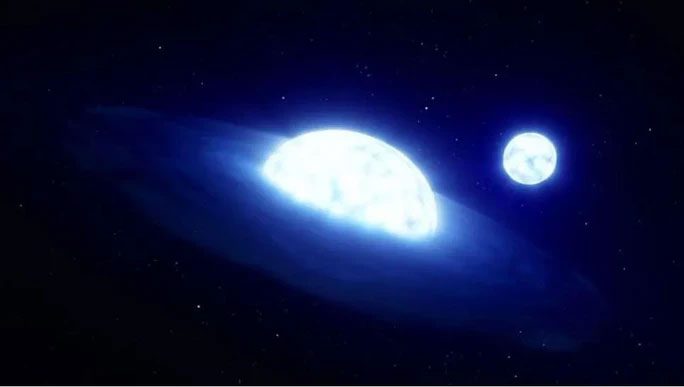In the process of studying mysterious Be stars, a type of cosmic “vampire,” scientists have uncovered evidence of another dangerous object.
Be stars have always been an intriguing mystery for astronomers. They are a subset of bright B-type stars. Unlike ordinary B stars, Be stars rotate very quickly and create rings of material around their orbits, a phenomenon not observed in other types of stars and one that remains poorly understood.
By analyzing data from the powerful satellites Gaia and Hipparcos, researchers from the University of Leeds (UK) have indicated that the strange characteristics of Be stars are due to interactions with two companion stars.

Be “monster” star and the distant victim star, stripped of its outer layers – (Illustration: ESO).
Be stars are thought to be a type of “cosmic vampire.” The theory suggests that this unusual type of star evolves from a binary star system consisting of two stars orbiting a common center.
Be stars “prey” on their smaller companions, turning them into victims. Material from the victim is drawn in, creating a ring of material around the Be star, while also accumulating angular momentum to increase its rotation speed.
In this new study, scientists focused on a particular issue: the range of binary star systems orbiting the same center appears too large for a Be star to effectively hunt and “siphon off” its companion.
This is a challenging answer to find, as only 28% of Be stars are identified with companions. There is a hypothesis that the companion star has become too faint to observe after a long period of being “drained.”
By examining data on other star types where one star has its material stripped away by a companion, scientists concluded that Be stars are likely part of a system with more than two stars.
In this scenario, the third star acts as a “vampire’s assistant,” orbiting at a greater distance outside the Be star and the “victim.”
The chaos of the three-star system has allowed this hidden assistant the opportunity to push the victim star closer to the Be star, while itself moving further away.
The close enough distance has made it easier for the Be star to “feed,” allowing it to develop better and achieve the “monster” state that astronomers often observe.


















































